We’re back with our roundup of our five favourite stories from the week. We’ve created two ways for you to get all caught up: skim through the stories below, or listen to our podcast (you can just stream it right here by pressing play👆). You can now also subscribe wherever you get your podcasts!
Here are the links to subscribe to the pod:
Topic #1: Harvard University pulls off major upset with a little help from Nike
With the grounds of Buffalo, N.Y.’s Audubon Golf Course crusted in a thick layer of ice, the convenors of the Northeast Regional NCAA D1 Cross Country Championships determined it was best to move the race to the roads. Coaches were informed of the decision around 10 p.m. on Wednesday, November 13, a day and a half before the race.
The short notice left some teams unprepared for the change in venue, particularly those who had already arrived in Buffalo. Many athletes competed in beat-up runners or plucked the pins out of their spikes.
In the end, Harvard dominated the race, placing three men in the top five and winning the men’s and women’s team titles. This was a major upset considering the men’s team went in ranked fourth and the women fifth. Syracuse placed second on the men’s side and Cornell finished second on the women’s. Interestingly, those three teams, Harvard, Syracuse, and Cornell, are all sponsored by Nike.
Why this matters
The Nike sponsored teams arrived at the start line decked out in pairs of Nike Vaporfly, the controversial tech currently propelling athletes to world records on the road. According to Lets Run, Alex Gibby, the Harvard coach, went as far as reserving pairs for athletes at a Dick’s Sporting Goods in Buffalo. The decision seemed to payoff as most of the teams that wore the Vaporfly placed better than predicted.
Bijan Mazaheri, a computing and mathematical science PhD student at Caltech, ran an analysis of the women’s results in Buffalo and found that the Vaporfly-wearing women saw a boost of at least 17 seconds over the 6k distance. While not quite equivalent to the promised four per cent improvement, it is significant.
What to look for next
At this point, there’s no arguing that the Vaporfly offer a clear advantage. This isn’t to diminish the accomplishments of Harvard’s athletes. They ran unbelievably fast with the men averaging 29:07 for 10k and the women averaging 20:03 for 6k. They also handily beat other teams outfitted in the Vaporfly, like Syracuse and Cornell.
This does, however, bring into question the legitimacy of using the Vaporfly in races, especially substantial races like championship qualifiers. If Harvard hadn’t been wearing the Vaporfly would they still have qualified for NCAAs? It’s hard to know. I guess we’ll just have to keep our eyes peeled for the crimson H in Terre Haute this weekend. Maybe they’ll surprise us.
Topic #2: Jordan Hasay opens up about Mary Cain and partners with a new coach

Jordan Hasay, one of America’s top distance runners and the country’s best shot at an Olympic medal in the marathon next year, finally commented on Mary Cain’s claims that coach Alberto Salazar mentally and emotionally abused her while training with the Nike Oregon Project (NOP).
Hasay, who trained with Salazar right up until September when he received a four year doping ban, told Runner’s World that “I really think you can’t point fingers and it’s really easy from the outside to kick Alberto under the bus. People make mistakes. He could have handled it at times differently. He really was doing his best.”
Hasay did commiserate with her former training partner and claimed she was unaware of how bad the situation was, but still seemed hesitant to condemn Salazar like some of the other NOP athletes. Instead, she is taking steps to move forward with her running career. This week, she officially announced that Paula Radcliffe, the former world record holder in the marathon, will be taking over as her “mentor-coach”. Much of the coaching will be done remotely as Hasay is living with her parents in California and Radcliffe recently purchased a property in Monaco.
Why this matters
Hasay’s response to Cain’s allegations feels more like a PR spin than her true gut reaction. It’s hard to believe that as one of Cain’s training partners, Hasay wouldn’t have noticed Cain’s struggles, particularly if Salazar’s shaming was in open view, as described by ex-teammates. Instead, she chalks it up to Cain being too young for the program; not experienced enough to rebuke Salazar’s abusive comments.
It’s likely Hasay is trying to walk a fine line between the media storm surrounding Cain and her loyalty to a coach she still respects, but the bland response feels like an apology for Salazar and does little to move forward the attempts to purge running culture of body shaming and retrograde concepts about “ideal weight.”
Hasay’s connection with Radcliffe, however, feels too contrived to be coincidental. Is this new pairing, perhaps, Radcliffe’s attempt to give her career a new direction after Brigid Kosgei shattered her world record at the Chicago Marathon this year? Or Hasay’s attempt to bleach her image squeaky clean after the Salazar scandal? Maybe both?
On a less cynical note, the pairing could also just be two very speedy women working together to achieve some awesome future results. It becomes an intriguing narrative going into 2020.
What to look for next
Hasay’s comments on Cain still leave us questioning exactly how the inner cogs of NOP whirred, but perhaps this is her way of putting the controversy behind her and focusing on her running. The new pairing with Radcliffe may shake things up in the right way, especially as Hasay comes off a torn hamstring. We wouldn’t be surprised to see her run a sub 2:20 marathon in the upcoming year.
Topic #3: The Performance of the year?

We thought 2019’s best runs were behind us.
It’s hard to outdo Brigid Kosgei’s earth-shattering 2:14:04 marathon or Eliud Kipchoge’s superhuman 1:59:40, but a 21-year-old Ethiopian just clocked a time that, somehow, might put both Kenyan superstars to shame.
Letesenbet Giday, the 10,000m silver medalist at the 2019 World Championship, averaged 2:57 per kilometre on route to a 15K world record of 44:19 on Sunday at the Zevenheuvelenloop (Seven Hills run) in Nijmegen, Netherlands. Like the name would suggest, the course wasn’t even flat.

Zevenheuvelenloop elevation profile
You can brush up own your Dutch and take in the entire race here (it’s quite a beautiful course, mostly through a tree-lined path in a park) :
How good is that?
A 15K performance is difficult to quantify, but deeper analysis makes one realize how outlandish was Giday’s run.
The previous record 15K world record belonged to Joyciline Jepkosgei, who split 45:37 on route to a 1:04:51 half-marathon. Jepkosgei is the reigning NYC marathon champion. Giday broke this mark by a full minute and 18 seconds.
Giday ran her last and fastest 10K of the race in 29:13. The 10,000m world record on the TRACK? 29:17.
A 44:19 is worth 1319 points on the IAAF points tables, and converts to the following half-marathon times:
Women’s half-marathon: 1:03:07 (current world record: 1:04:51)
Men’s half-marathon: 53:07 (current world record: 58:01)
What this means?
Giday has yet to run a major marathon, or even a noteworthy half. If she projects well, she could crush the world at the Tokyo Olympic 10,000m in the short term, and re-write running’s increasingly tantalizing record book in the long term. But, can the precocious talent continue to improve, or at least maintain this unchartered level of fitness?
Here’s to hoping Giday can produce such performances for years to come—she is only 21, after all.
Topic #4: Was this the deepest half-marathon in history?🇯🇵
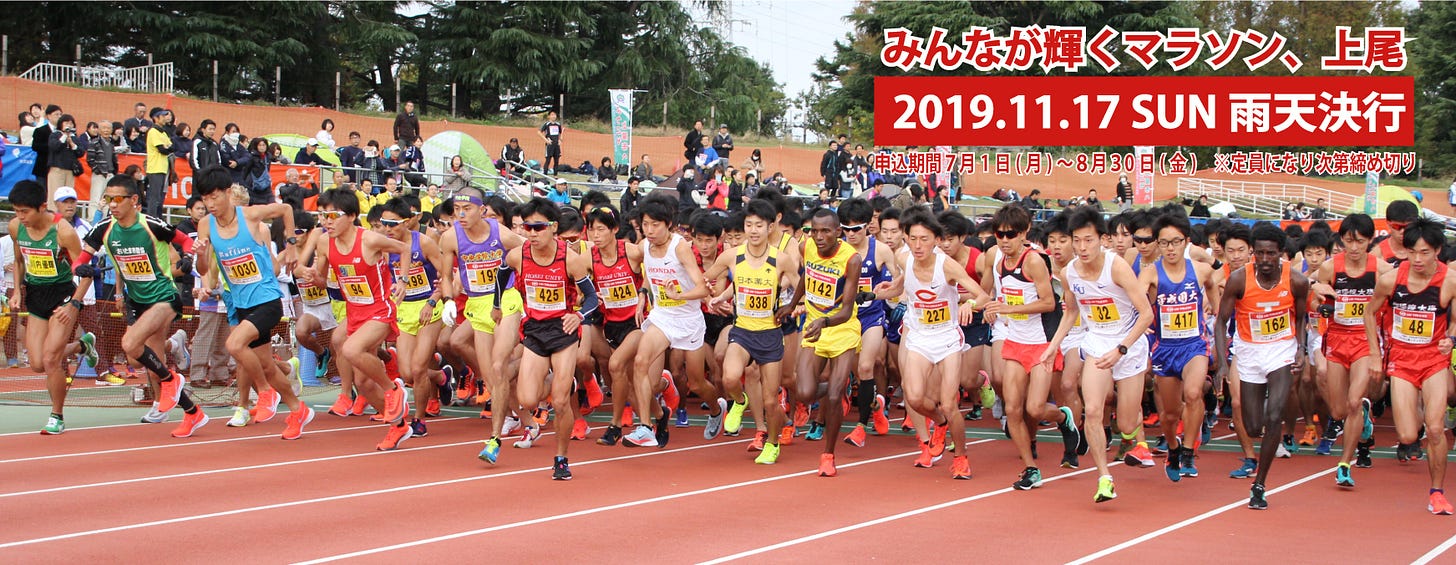
A race that starts on the track + a field loaded with Nike Vaporflys = insanely fast results
On Sunday, nearly 400 runners ran under one hour and 10 minutes (yes, you read correctly) at the Ageo Half-Marathon in Japan.
Let’s put that into context. Japan Running News tweeted the finish times of several racers. We list those times below, and compare them to the corresponding finish times at the 2019 Toronto Waterfront Half-Marathon, itself considered a large, fast race by North American standards.
Place - Ageo half-marathon time - (Time for corresponding placing in Toronto)
1st - 1:01:26 - (1:03:08)
10 - 1:02:54 - (1:09:40)
25 - 1:03:23 - (1:13:49)
50 - 1:03:52 - (1:18:51)
100 - 1:04:35 - (1:22:34)
150 - 1:05:24 - (1:25:32)
200 - 1:06:05 - (1:27:21)
300 - 1:07:46 - (1:29:59)
400 - 1:10:08 - (1:32:44)
The Yuki effect?
Such a deep field outside of Kenya and Ethiopia is unheard of.
Our theory: the charismatic 2018 Boston marathon champion Yuki Kawauchihas fuelled a love for fast running already inherent to Japan.

Yuki Kawauchi posing with fans at the 2016 Ageo Half-Marathon
Japan needs a new breakout star
Japan may have a deeper distance running pool than most countries in the world, but produce very few world beaters.
The nation has not won a women’s medal in the Olympic marathon since 2004 or a men’s medal since 1992. Can some of these top Japanese runners make the jump and be competitive at home in next summer’s Olympic marathon?
Mizuni Noguchi (women - 2:19:12) and Suguru Osako (men - 2:05:50) are the nation’s best chances at the podium.
And Finally… The greatest marathon on skates
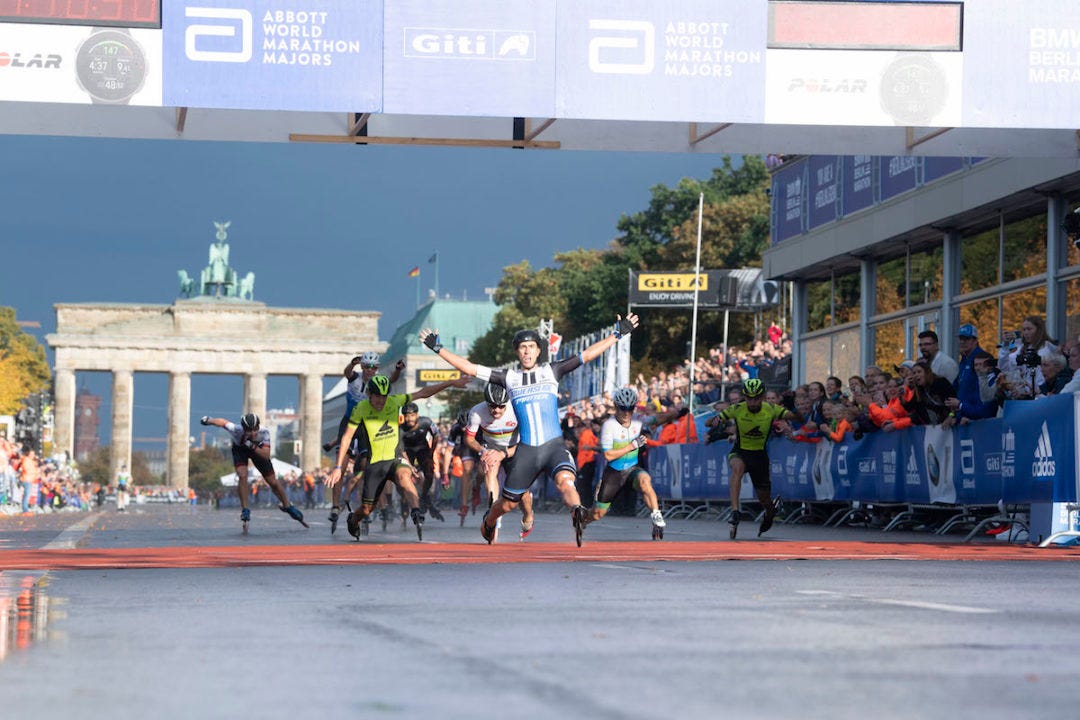
Writer Ally Beaven discovered in September that we’ve all been racing the wrong Berlin Marathon. The real deal, he argues, isn’t the prestegious 47,000-person event held on the Sunday, but the much faster, more intimate event skated the afternoon beforehand.
Beaven is talking about the Berlin Inlineskating Marathon. Same 42.195 kilometres of glory, except in rollerblades. He describes the experience as such:
Skating through Berlin is a joy. Try rollerblading the course of any UK marathon and at best you’ll need a few new fillings. At worst extensive skin grafts and a couple of plaster casts. Rolling through Berlin is like skating on a snooker table. Floating on air in your finest silk slippers.
And even on the occasions when tram lines distrupt this frictionless reverie, all you can think is I bet those form part of a well integrated, affordable public transport system. Famous landmarks whizz by and then, before you know it, you’re done.

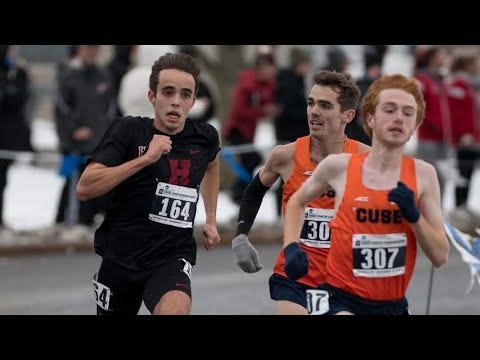




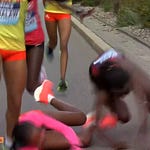


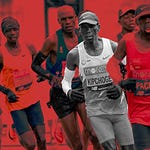

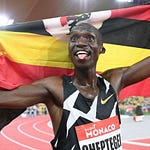
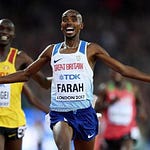
Share this post